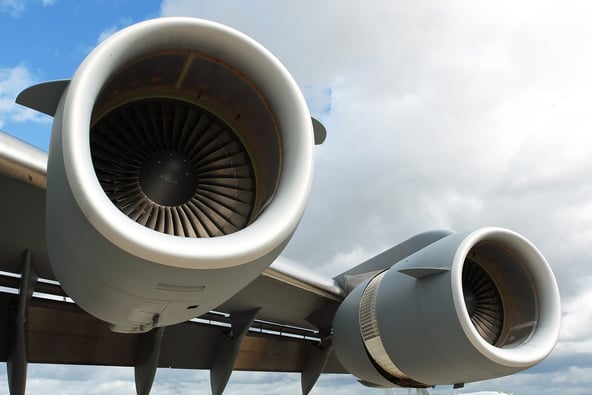
REVIEW. The global air cargo industry broke traffic records in 2024. Cargo revenues are on the rise again, and the trend is expected to continue in 2025.
1/ The evolution of supply and demand
- December 2024 traffic
The month of December confirmed the good health of air freight in 2024. Global traffic in tonne-kilometres increased by 6.1% year-on-year, according to figures from the International Air Transport Association (IATA). This is the 17th consecutive month of growth. On a month-on-month basis, the increase is limited to 0.9% in data adjusted for seasonal variations, representing traffic of around 24.2 billion tonne-kilometres (t-km), according to our estimates.

* CTK: cargo tonne-kilometres - Data source: IATA.
On international routes, traffic increased by 7%. The main routes are progressing, with the exception of the Africa-Asia corridor, down 4% year-on-year. Intra-Asia traffic leads the way in growth going up by 11%, closely followed by the Europe-Asia corridor, which recorded its 22nd consecutive month of year-on-year growth with a rise of 10.3% in December. The world's leading route in terms of volume, the Asia-North America corridor posted an 8% year-on-year increase, its 14th consecutive month of expansion.
- Annual cumulative total at the end of December 2024
Global air freight demand is expected to increase by 11.3% in 2024 compared to 2023, and by 12.2% on international routes. The sector thus reaches a new historical record, exceeding by 0.5% the volumes of the previous record reached in 2021, during the post-Covid recovery period. As such traffic amounted to around 275 billion tonne-kilometres.

* CTK: cargo tonne-kilometres - Data source: IATA.
The performance of the air freight industry is all the more remarkable given that in 2024, global trade in goods grew by only 3.6%. The sector has benefited in particular from strong growth in cross-border e-commerce, but also from a number of exogenous factors, starting with disruptions to maritime transport in the Red Sea. The global air freight industry has thus recorded significantly higher growth than in initial forecasts, since in December 2023, IATA projected a 17.3% drop in global cargo turnover, for a 4.5% rise in traffic.
- Capacity
Capacity offered increased by 3.7% in December 2024 year-on-year, and by 0.7% month-on-month after seasonal adjustment. According to our estimates, it amounted to approximately 52.2 billion tonne-kilometres. For the whole of 2024, the supply showed a growth of 7.4%, much more moderate than the increase in traffic.
On international routes, the increase in capacity is mainly fuelled by the growth of that in the belly hold of passenger aircraft. It increased by 6.5% in December year-on-year, representing 53.9% of the total supply on international routes, compared to 53.2% in December 2023. For the 9th consecutive month, all-cargo supply increased (+3.8% in December year-on-year), but its share fell from 46.8% in December 2023 to 46.1% in December 2024. Overall, in 2024, 54.8% of supply came from belly hold capacity, compared to 45.2% for all-cargo capacity. In 2023, these figures were 52.5% and 47.5% respectively.
The evolution of demand exceeding that of supply has allowed an increase in the load factor. In December 2024, it stood at 52.5% internationally, up 0.9 percentage points year-on-year. For the whole year, it increased by 0.5 points to 51.3%.
2/ Price trends
In addition to breaking a new record for traffic, the global air cargo industry has also managed to ensure profitable growth in 2024, despite an erosion in average unit revenue that IATA estimates at -3.7% compared to the previous year. This decline is significantly lower than the -21% forecast in December 2023 by IATA for the year 2024, and unit revenue remains 53.4% above the pre-Covid level of 2019.
Cargo revenues for global companies have started to rise again, estimated at $149 billion, compared to $139 billion in 2023. This time, the 2021 record of $210 billion has not been broken.

In December, unit revenue, including surcharges, saw a slight month-on-month decline of 0.4%, the first in five months, IATA said. But it is still up 6.6% year-on-year.
Price changes have been quite heterogeneous. In December, for example, we see a slight month-on-month increase of 1.5% on the Europe/North America East Coast corridor. This can be explained in particular by an increase in orders, linked to two exceptional factors: the prospect of additional customs tariffs with the arrival of Donald Trump as President of the United States and the threat of strikes in the ports on the East Coast of the United States. This strike, which was planned to start on January 15, ultimately did not take place, an agreement between the dockers and the handling companies having been reached a week before the deadline.
On a year-on-year basis, as Upply data shows, it is also an external factor that has helped support freight rates on certain routes and avoid a general decline. Attacks by Houthi rebels on ships transiting the Suez Canal have led to a massive diversion via the Cape of Good Hope, lengthening shipping times and disrupting supply chains while the new routes were put in place. This factor has encouraged the use of air freight and helped maintain freight rates on the Asia-Europe corridor.

Source: Upply Freight Index
3/ The outlook
According to IATA's 2025 forecast, the air cargo industry is expected to continue to grow in 2025. Traffic is expected to rise by 5.8% and turnover by 5.7% to reach $157 billion. The unit revenue should suffer a decrease of 0.5%.

However, economic and geopolitical uncertainties make forecasting a particularly risky business. “Economic fundamentals point to another good year for air cargo, with oil prices on a downward trajectory and trade continuing to grow. There is no doubt, however, that the air cargo industry will be challenged to adapt to unfolding geopolitical shifts. The first week of the Trump administration demonstrated its strong interest in using tariffs as a policy tool that could bring a double whammy for air cargo, boosting inflation and deflating trade,” said Willie Walsh, IATA’s Director General.
So far, a number of announcements of additional customs tariffs have been followed by immediate postponements of their entry into force. We will therefore have to wait a few weeks to know the general framework that should prevail in 2025, assuming that a certain stability is achieved. However, it appears at this stage that cross-border e-commerce, which boosted air freight activity in 2024, is likely to be impacted by this trade war, through additional customs tariffs, but also through regulatory changes regarding the maximum value of certain shipments that allows them to be exempt from customs duties.
- Increased surveillance of cross-border e-commerce
The Trump administration announced the suspension of the de minimis customs rule, which exempted shipments worth less than $800 from customs duties. Legislation that was already in the sights of the Biden administration, which had initiated a two-stage reform.
The United States is not the only one to point the finger at this loophole that has led to an exponential increase in the number of exempted packages being shipped. The European Commission also presented a press release on e-commerce on 5 February, calling on member countries to rapidly adopt the Customs Union Reform Package of measures, which provides in particular for the abolition of the exemption from duties for parcels with a value of less than EUR 150.
Both the United States and the European Union want to also strengthen controls, because this shipping route is now popular for the transport of illicit goods.
- Moderate economic growth
Apart from the uncertainties in this e-commerce market, the global economic forecasts and geopolitical tensions also cast some clouds over the outlook for the air freight industry.
In December, the Manufacturing Purchasing Managers Index (49.2) and the New Export Orders PMI (48.2) were both below the 50 threshold, indicating a decline in global manufacturing production and exports. The World Bank also anticipates "a moderate expansion of global growth of 2.7% in 2025." The Eurozone's gross domestic product (GDP) is expected to grow by just 1%, compared with 2.3% for the United States and 4.5% for China. This does not mean that these two economies are free of difficulties. The United States is struggling to contain inflation. This increased by a further 0.2 percentage points to reach 2.9% in December (+2.7% in the EU). The introduction of new customs tariffs could further accentuate the phenomenon. China is experiencing the opposite situation with consumer price inflation of only 0.1% in December and a 4th consecutive month of year-on-year decline, "reinforcing fears of an economic slowdown", underlines IATA.
In 2025 as in 2024, economic and geopolitical hazards could therefore once again thwart forecasts.
Please enter your details below to download the Air Cargo Industry 2024 Review:
Our latest articles
-
Subscriber 2 min 19/12/2025Lire l'article -
Container shipping in 2025
Lire l'article -
Air cargo: the rerouting of flows is confirmed
Lire l'article



